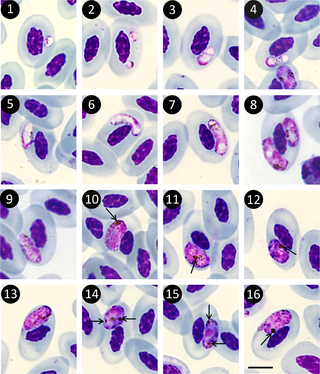
Plasmodium is a genus of unicellular eukaryotes that are obligate parasites of vertebrates and insects. The life cycles of Plasmodium species involve development in a blood-feeding insect host which then injects parasites into a vertebrate host during a blood meal. Parasites grow within a vertebrate body tissue before entering the bloodstream to infect red blood cells. The ensuing destruction of host red blood cells can result in malaria. During this infection, some parasites are picked up by a blood-feeding insect, continuing the life cycle.

The Plasmodiidae are a family of apicomplexan parasites, including the type genus Plasmodium, which is responsible for malaria. This family was erected in 1903 by Mesnil and is one of the four families in the order Haemospororida.
Giovanolaia is a subgenus of the genus Plasmodium created by Corradetti et al. in 1963. The parasites within this subgenus infect birds.
Haemamoeba is a subgenus of the genus Plasmodium — all of which are parasites. The subgenus was created in 1963 by created by Corradetti et al.. Species in this subgenus infect birds.

Laverania is a subgenus of the parasite genus Plasmodium. Infection with these species results in malaria. The subgenus was first described in 1958.
Huffia is a subgenus of the genus Plasmodium - all of which are parasites. The subgenus was created in 1963 by Corradetti et al.. Species in this subgenus infect birds with malaria.
Novyella is a subgenus of the genus Plasmodium - all of which are parasites. The subgenus was created in 1963 by Corradetti et al. Species in this subgenus infect birds. It unites the avian malaria parasites with small erythrocytic meronts and elongated gametocytes.
Vinckeia is a subgenus of the genus Plasmodium — all of which are parasitic alveolates. The subgenus Vinckeia was created by Cyril Garnham in 1964 to accommodate the mammalian parasites other than those infecting the primates.
Plasmodium caprae is a parasite of the genus Plasmodium subgenus Vinckeia.
Plasmodium durae is a parasite of the genus Plasmodium subgenus Giovannolaia.
Sauramoeba is a subgenus of the genus Plasmodium, all of which are parasitic eukaryotes. The subgenus was created in 1966 by Garnham. Species in this subgenus infect reptiles.
Carinamoeba is a subgenus of the genus Plasmodium - all of which are parasitic unicellular eukaryotes.
Lacertamoeba is a subgenus of the genus Plasmodium — all of which are parasites. All species in this subgenus infect reptiles.
Ophidiella is a subgenus of the genus Plasmodium created in 1966 by Garnham.
Plasmodium hegneri is a parasite of the genus Plasmodium subgenus Giovannolaia.

The Haemosporida are an order of intraerythrocytic parasitic alveolates.
Paraplasmodium is a subgenus of the genus Plasmodium - all of which are parasitic eukaryotes. The subgenus was created by Telford in 1988. Species in this subgenus infect lizards.
Papernaia is a subgenus of the genus Plasmodium, all of which are parasitic protozoa. The subgenus was created in 2010 by Landau et al.
Plasmodium billbrayi is a parasite of the genus Plasmodium subgenus Laverania.


